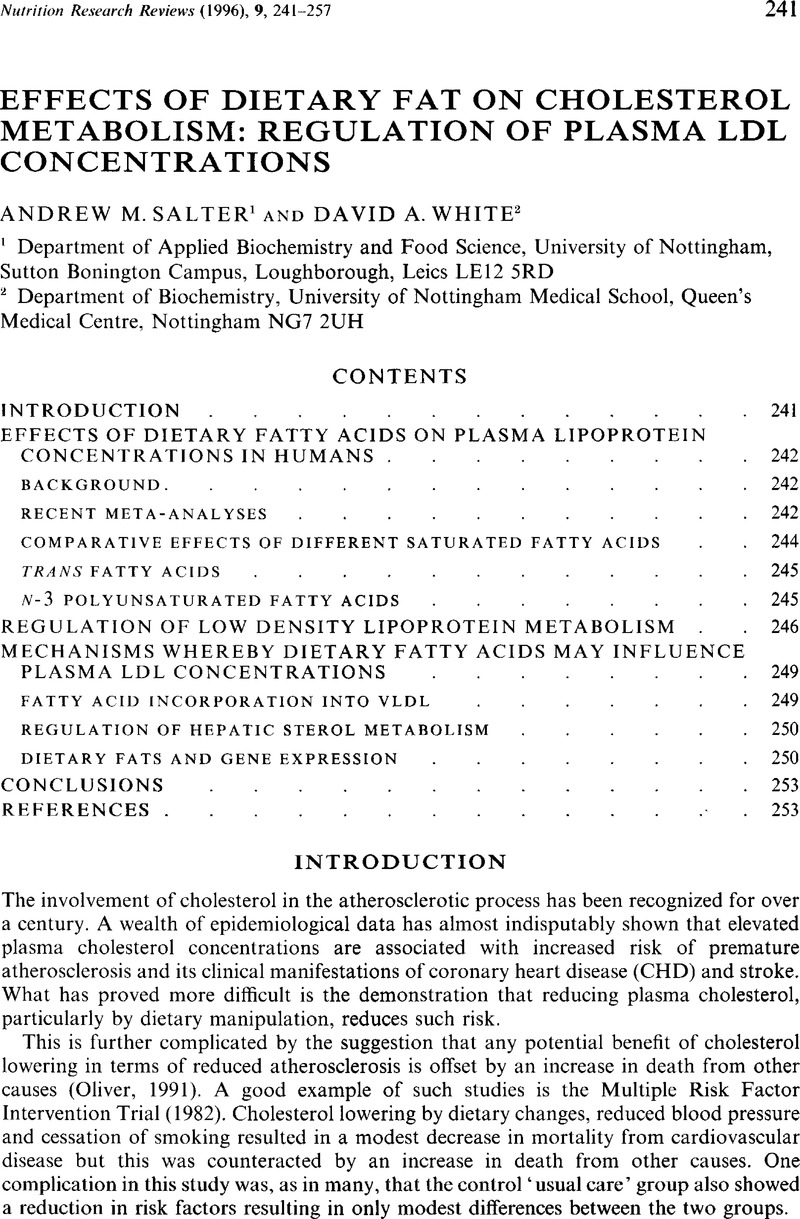Crossref Citations
This article has been cited by the following publications. This list is generated based on data provided by Crossref.
Gurr, M. I.
1997.
Lipids: From intractable grease to oil for the wheels of life.
British Journal of Nutrition,
Vol. 77,
Issue. 6,
p.
827.
Bucci, Cecilia
Serù, Rosalba
Annella, Tiziana
Vitelli, Rosalba
Lattero, Daniela
Bifulco, Maurizio
Mondola, Paolo
and
Santillo, Mariarosaria
1998.
Free fatty acids modulate LDL receptor activity in BHK-21 cells.
Atherosclerosis,
Vol. 137,
Issue. 2,
p.
329.
White, David A.
Bennett, Andrew J.
Billett, Michael A.
and
Salter, Andrew M.
1998.
The assembly of triacylglycerol-rich lipoproteins: an essential role for the microsomal triacylglycerol transfer protein.
British Journal of Nutrition,
Vol. 80,
Issue. 3,
p.
219.
Broun, Pierre
Gettner, Sharmeen
and
Somerville, Chris
1999.
GENETIC ENGINEERING OF PLANT LIPIDS.
Annual Review of Nutrition,
Vol. 19,
Issue. 1,
p.
197.
Zulet, Mᵃ Angeles
Barber, Ana
Garcin, Henri
Higueret, Paul
and
Martínez, José Alfredo
1999.
Alterations in Carbohydrate and Lipid Metabolism Induced by a Diet Rich in Coconut Oil and Cholesterol in a Rat Model.
Journal of the American College of Nutrition,
Vol. 18,
Issue. 1,
p.
36.
Billett, Michael A.
Bruce, Jennifer S.
White, David A.
Bennett, Andrew J.
and
Salter, Andrew M.
2000.
Interactive effects of dietary cholesterol and different saturated fatty acids on lipoprotein metabolism in the hamster.
British Journal of Nutrition,
Vol. 84,
Issue. 4,
p.
439.
Ruiz-Roso, B.
and
Varela, G.
2001.
Frying.
p.
59.
2002.
Lipid Biochemistry.
p.
170.
Daniel, Z. C. T. R.
Richards, S. E.
Salter, A. M.
and
Buttery, P. J.
2004.
Insulin and dexamethasone regulate stearoyl-CoA desaturase mRNA levels and fatty acid synthesis in ovine adipose tissue explants1,2.
Journal of Animal Science,
Vol. 82,
Issue. 1,
p.
231.
Karthikeyan, K.
Sarala Bai, B.R.
and
Niranjali Devaraj, S.
2007.
Efficacy of grape seed proanthocyanidins on serum and heart tissue lipids in rats subjected to isoproterenol-induced myocardial injury.
Vascular Pharmacology,
Vol. 47,
Issue. 5-6,
p.
295.
Senthil, S.
Sridevi, M.
and
Pugalendi, K. V.
2007.
Protective Effect of Ursolic Acid Against Myocardial Ischemia Induced by Isoproterenol in Rats.
Toxicology Mechanisms and Methods,
Vol. 17,
Issue. 1,
p.
57.
Punithavathi, V.R.
and
Prince, P. Stanely Mainzen
2009.
Combined effects of quercetin and α-tocopherol on lipids and glycoprotein components in isoproterenol induced myocardial infarcted Wistar rats.
Chemico-Biological Interactions,
Vol. 181,
Issue. 3,
p.
322.
Devika, P. T.
and
Stanely Mainzen Prince, P.
2009.
Preventive effect of (−)epigallocatechin gallate on lipids, lipoproteins, and enzymes of lipid metabolism in isoproterenol‐induced myocardial infarction in rats.
Journal of Biochemical and Molecular Toxicology,
Vol. 23,
Issue. 6,
p.
387.
Vallim, T.
and
Salter, A.M.
2010.
Regulation of hepatic gene expression by saturated fatty acids.
Prostaglandins, Leukotrienes and Essential Fatty Acids (PLEFA),
Vol. 82,
Issue. 4-6,
p.
211.
Prince, Ponnian Stanely Mainzen
and
Sathya, Balakrishnan
2010.
Pretreatment with quercetin ameliorates lipids, lipoproteins and marker enzymes of lipid metabolism in isoproterenol treated cardiotoxic male Wistar rats.
European Journal of Pharmacology,
Vol. 635,
Issue. 1-3,
p.
142.
Prahalathan, Pichavaram
Saravanakumar, Murugesan
and
Raja, Boobalan
2012.
The flavonoid morin restores blood pressure and lipid metabolism in DOCA-salt hypertensive rats.
Redox Report,
Vol. 17,
Issue. 4,
p.
167.
Frankel, Edwin N.
2012.
Lipid Oxidation.
p.
391.
Radhiga, Thangaiyan
Rajamanickam, Chellam
Senthil, Selvaraj
and
Pugalendi, Kodukkur Viswanathan
2012.
Effect of ursolic acid on cardiac marker enzymes, lipid profile and macroscopic enzyme mapping assay in isoproterenol-induced myocardial ischemic rats.
Food and Chemical Toxicology,
Vol. 50,
Issue. 11,
p.
3971.
Pogula, Bharath Kumar
Maharajan, Mari Kannan
Oddepalli, Divya Rekha
Boini, Lavanya
Arella, Mounika
and
Sabarimuthu, Darlin Quine
2012.
Morin protects heart from beta-adrenergic-stimulated myocardial infarction: an electrocardiographic, biochemical, and histological study in rats.
Journal of Physiology and Biochemistry,
Vol. 68,
Issue. 3,
p.
433.
Salter, A.M.
2013.
Dietary fatty acids and cardiovascular disease.
Animal,
Vol. 7,
Issue. ,
p.
163.



